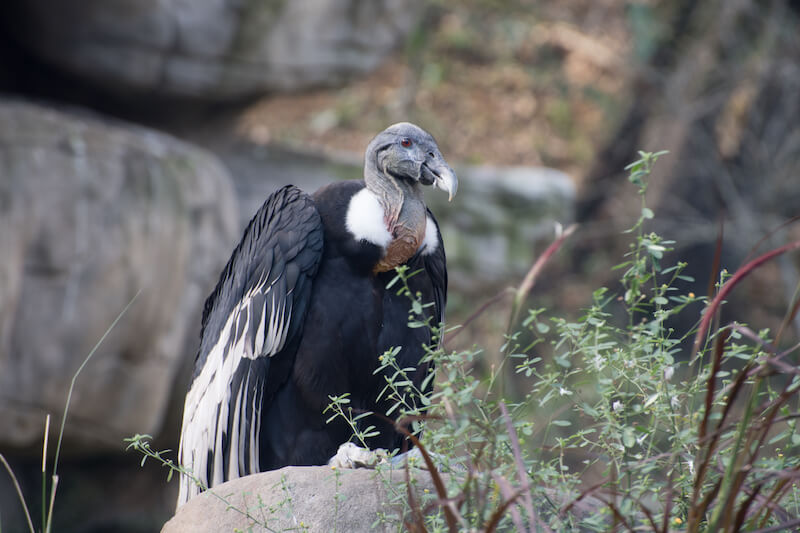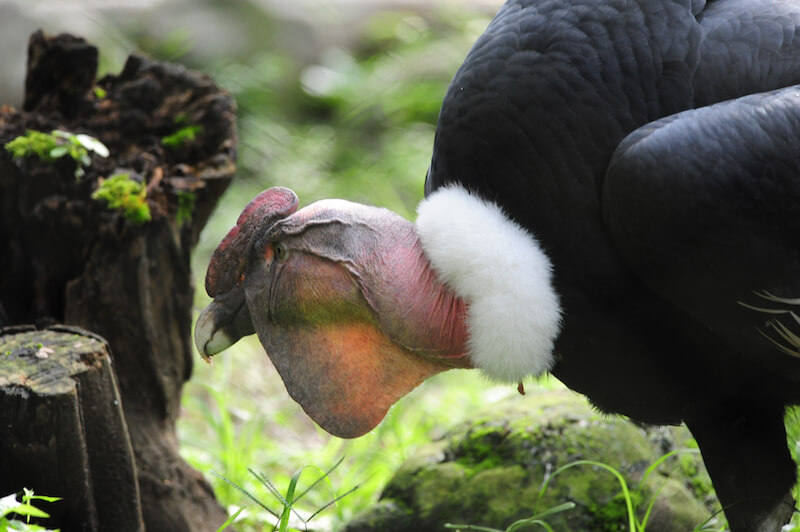ANDEAN CONDOR
Condor de los Andes
Vultur gryphus
Ave Nacional de Colombia
The condor is a large and heavy bird. It has a dark black plumage. The wingspan measures around 3.5 m. Its length reaches 1 m and a weight of approximately 12 Kg. It inhabits in open areas, rests and sleeps in caverns. It is found up to 3000 m altitude. It has a sharp sight and has a sensitive sense of smell. The male has brown eyes and reddish in the female. Its head is small and featherless. The condor introduces its head into the prey. The feathers of the neck are impermeable and do not stain with the blood when feeding on the decomposing animal. Neck is naked. Wings show a white band. The bill is curved, and the feet strong both designed to easily grab decomposing meat. The fact that they clean the environment from dead animals means that they protect healthy animals of the ecosystems against pathogens. It is able to consume 5 Kg of meat and abstain for 5 weeks. They are usually alone. Their flight taks advantage of the thermic drafts to flight without flapping the wings. They sleep in caverns and can live from 50 to 85 years. The condor keeps its partner for life. Clutch is 1 egg that both parents incubate for 2 months. When old or too weak they plunge to death. In extinction.
El cóndor es una de las aves más grandes y pesadas que existen. De color negro azabache. Su envergadura alar alcanza los 3.5 m, de 1 m de largo 12 Kg de peso. Se encuentra en lugares amplios y despejados, en sitios rocosos hasta los 3000 m. Posee un agudo sentido de la vista y del olfato. Los machos tienen iris café y rojizo en la hembra. Su cabeza pequeña desprovista de plumas la aprovecha para introducirla dentro de la presa. Los machos con una carúncula o cresta que carece en las hembras. El cuello presenta plumas impermeables a la sangre cuando se alimentan. Tales plumas cubren un poco la piel desnuda del cuello. Alas con una visible franja de color blanco; su pico es curvo y patas fuertes están diseñadas para desgarrar animales muertos en descomposición. Son muy útiles para mantener el equilibrio de los ecosistemas ya que eliminan focos de contaminación. Pueden comer hasta 5 Kg de carroña por día y no comer por 5 semanas. Aves solitarias. Vuelan majestuosamente casi todo el tiempo y aprovechan las corrientes de aire para mantenerse suspendidas en el aire. Se refugian en cuevas y viven entre 50 a 85 años. Monógamas. Postura de un solo huevo que ambos padres incuban por 2 meses. Cuando se acaban sus fuerzas se dejan caer en picada y muere. En peligro de extinción.

LAM_0034

LM1_4897

LAM_0038
